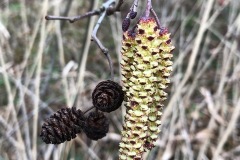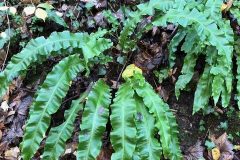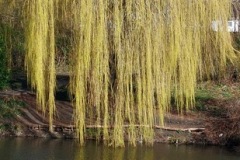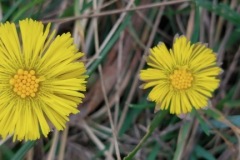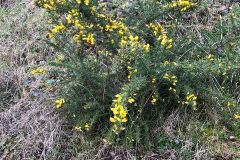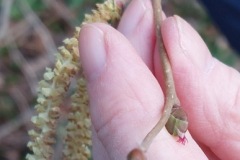Leader: Nora Boyle.
Members Present: Tom (H), Ian (F), Carolyn (B), later joined by Colin (H).
At 10.30 on a chilly morning with a cold North-easterly wind the group met at the northern car park of Brodsworth Community Woodland. We walked via the eastern boundary path of the Community Woodland where we admired the male and female flowers on the numerous examples of Alder, the female flowers which eventually become cones appearing above the hanging catkins.
We then followed a section of the Roman Ridge down to Hanging Wood, past the allotments and on to Highfield Lake Country Park. We returned via the walkway along the abandoned mineral line of the South Yorkshire Junction Railway, which ran from the former colliery marshalling yard to the west of the Roman Ridge, east to join the LNER Doncaster/Wakefield line at Castle Hills/ Radcliffe Moat. Not only does this cutting provide good exposures of the Permian Upper Magnesian Limestone, these exposures are colonised by populations of the attractive Harts-tongue Fern Asplenium scloropendrium, these plants shining glossy green in the otherwise leafless winter woodland.
Although in an otherwise heavily managed and artificial landscape, Hanging Wood (on the rising land to our left) gives every evidence of being a survival of native limestone woodland. It still contains limestone indicator species such as Dogwood Cornus sanguinea, Wild Privet Ligustrum vulgare, Ash Fraxinus excelsior and Wych Elm Ulmus glabra.
Evidence of a calcicolous herb layer were areas dominated by Dog’s Mercury Mercurialis perennis in flower, bluebell leaves and the dead dry stems of Wood false-brome Brachypodium sylvaticum and Hairy Brome Bromopsis ramosa. The managed history of the woodland is revealed in the presence of ornamental and commercial plantation species such as the occasional Horse Chestnut Aesculus hippocastanum, Beech Fagus sylvatica and the dominant species Sycamore Acer pseudoplatanus. Other evidence of human activity was the spectacular amounts of litter and flytipping. However, it must be reported that Caroline had come equipped with callipers and bin bags and spontaneously commenced 3, to rid the landscape of the offending debris as we walked along. Additional exotics were present in the Highfield Lakes Country Park. These included shrubs of Sea buckthorn Hippophae rhamnoides, impressively full of berries, and water-side Weeping Willows (Salix babylonica) both on the island and the north bank.
Caroline sampled some of the Sea buckthorn berries and pronounced them to have the ‘zing’ of Sherbet-lemons (!). The two lakes, fed by the Langthwaite Dyke with rather turbid water from the ex-colliery site to the west, are fringed by occasional native riparian trees such as Crack Willow Salix fragilis, Osier Salix viminalis and Common Alder Alnus glutinosa plus emergent species like Reedmace Typha latifolia, Branched Burreed Sparganium erectum, Common Reed Phragmites australis and Water Plantain Alisma plantago-aquatica. Counted on the lower lake were 14 Mallard and 3 Moorhens. Formerly the lakes had a considerable ornamental wildfowl population, now departed.
As the day progressed the sun came out and reluctant spring flowers opened up, revealing Snowdrop Galanthus nivalis, Lesser celandine Ranunculus ficaria, Colts Foot Tussilago farfara, Dandelion Taraxacum officinale agg., Daisy Bellis perennis, Red Dead-nettle Lamium purpureum and Bird’s-eye Speedwell Veronica chamaedrys in flower.
As we reached Brodsworth Community Woodland again the brilliant sunshine gloriously illuminated flowering Gorse Ulex europaeus bushes and the Hazel coppices festooned with catkins positively glowed yellow. We were reminded of the miniscule red female flowers of the Hazels Corylus avellana. e. Other botanical items of note were the dead seed heads of Teasel Dipsacus fullonum and Water Figwort Scrophularia auricullata.
Birds were generally few, though territorial singing by Robins, Song Thrushes, Mistle Thrushes, Blackbirds and Great tits was a distinct sign of spring. Other birds present were Carrion Crow, Jackdaw, Magpie, Starling, Blackheaded Gull, a Common Buzzard (circled overhead) and a pair of Chaffinches in full breeding plumage were watched basking in the sunshine. Also coaxed out by the midday sun was a queen Bumblebee Bombus lucorum. Tom and Ian were always on the look out for galls and noted 3 in particular. Marble galls caused by the cyanid wasp Andricus kollari, stem galls on Bramble caused by another cynapid wasp, Diastrophus rubi, and Cigar galls on Common Reed Phragmites australis caused by the fly Lipara lucens. Even on this chilly day, it was heartening to see that the area was very well used by the public, these including walkers, joggers, dog walkers and cyclists. Our group terminated its interesting walk with hot drinks and snacks at the
café of the adjacent Manvers Grange Garden centre after which Tom and Ian were resolved to return to Hanging Wood to do some serious plant-gall recording.
CAH.
